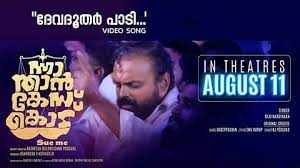
When Bharathan’s Kathodu Kathoram was released in 1985, I was in high school. It was a time of movies with great stories and music. A time when directors, script writers, music directors, and even lyricists were all considered superstars. In discussions in school and college campuses, it was not just the actors that got attention, but the makers as well. Thankfully, directors and writers are still heroes in Malayalam film industry and the story is still the king.
Kathodu Kathoram had such captivating songs that Ouseppachan became a household name, who went on to winning many national and state awards. With his violin, he took the audience to a different world. And one of the songs in the movie was “Devadoothar padi … .” With lyrics by ONV Kurup, the song had A. R. Rahman at the keyboard and Shivmani at the drums, much before both of them became superstars in their own right.
In the last week of July this year, a song clip, with the same song but from a new movie, Nna Thaan Case Kodu (Sue Me) by Ratheesh Balakrishnan Poduval (Android Kunjappan Ver 5.2 fame) hit YouTube. On the first day, it clocked over a million views, and by the fourth day, it has crossed 7 million views, with thousands of user-created versions storming the internet.
It is fascinating to see a song that is close to four decades old is reliving and catching the imagination of a whole new generation. In science, the field of Memetics (based on evolutionary theory) deals with how bits of cultural information evolve and are transmitted from one person to other. Memetics was there before internet. Memetic theories have been used to understand how a content becomes viral in this era of hyper-connectivity. It is often a combination of factors that touches us (the biochemistry), which makes us share a content, making it viral.
In this case as well, a slew of factors that came together to make this a sensation.
For one, the original song itself was a hugely popular and a hit those days. Second, the feeling of nostalgia is so strong, especially for people above 40s in this case. Third, Ouseppachan’s strong hold on us (remember, this is a place where music directors are also revered). Fourth, Kunchacko Boban’s place in the hearts of Malayalee movie enthusiasts—as the neighborhood boy/man with all his vulnerabilities (and not the toxic masculinity). And fifth, a relatable and funny scene that plays out every day in any festival ground anywhere in Kerala.
And once it became popular and as more people shared and the media covered, the creators propelled it further by creating their own versions, creating a tsunami of sorts.
This was no marketing gimmick (or so I would like to believe). This was perhaps the combination of all right emotional reasons, with Kunchacko himself acknowledging with a lot of humility about how unexpected this was, and the soaring expectations on him and the film.
In the end, good stories and good music transcends time. And in the digital world, it finds new ways and forms of life.